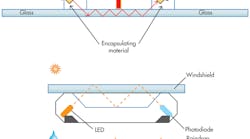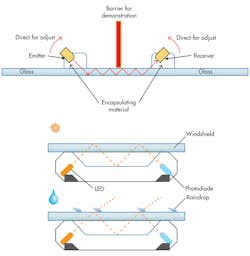In this article, we implement a rain and ice sensor by analyzing the reflection of an infrared (IR) light source. This project uses proven techniques based on multiple reflections of IR light in the internal walls of the target glass. It will aim to increase the capabilities of standard components by adding technical advantages offered by the LED device, such as increasing the power emission using pulsed energy applied 10 times using high current strikes at a 1% duty cycle.
Application
The most common practice in the detection of raindrops on a windshield involves sensing infrared light conducted through the internal walls of the windshield glass (Fig. 1). In some cases, these reflections are enhanced by adding other physical components to the glass.
1. Internal reflection principle used in the most common rain sensors.1
When raindrops are present on the external surface of the glass, a refraction of light happens and takes away part of the initial light stream. This results in an attenuated beam of IR light as compared to the original conditions (without the presence of water).

